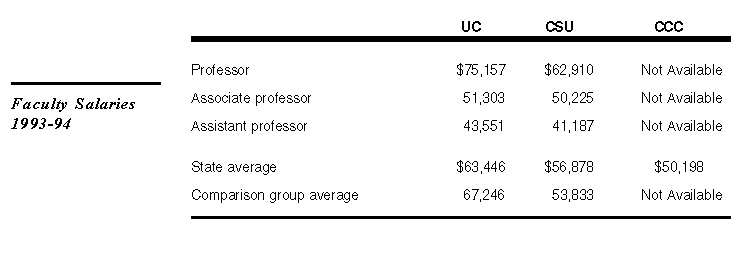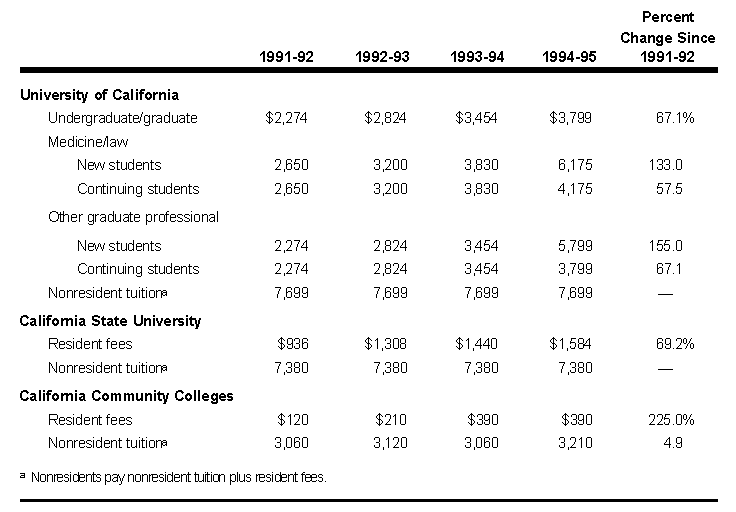
 Legislative Analyst's Office
Legislative Analyst's Office
Since 1991-92, systemwide resident undergraduate fees increased by $1,525 (67 percent) at the UC, $648 (69 percent) at the CSU, and $270 (225 percent) at CCC. These fee increases partially offset the effect of declining General Fund support during this time period.
Nonresident tuition did not increase at the UC and the CSU over the past three years and increased by only 4.9 percent at the CCC because major nonresident tuition increases had occurred earlier.

Compared to similar institutions in other states, California's resident undergraduate fees (systemwide and campus-based) in 1993-94 were:
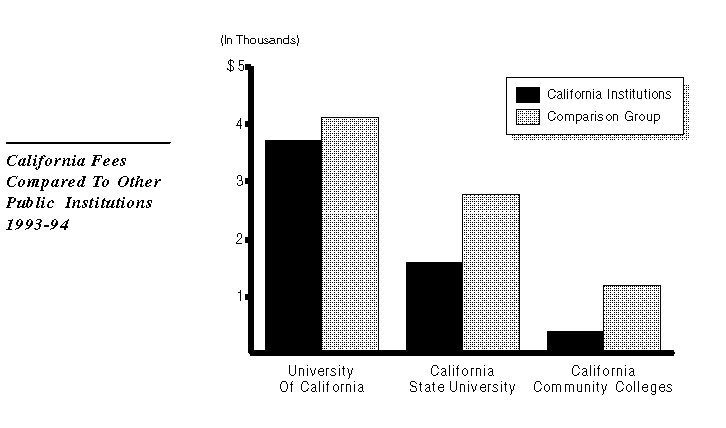
Of the $3.5 billion in 1993-94 financial aid in California:
Over one-half the financial aid is from loans. Loans are becoming an increasingly large component of financial aid--increasing from $737 million in 1985-86 to almost $1.8 billion in 1993-94. This is due to several factors, including the rising costs of attending college, the greater availability of loans rather than grants, and declines in the economy generally.
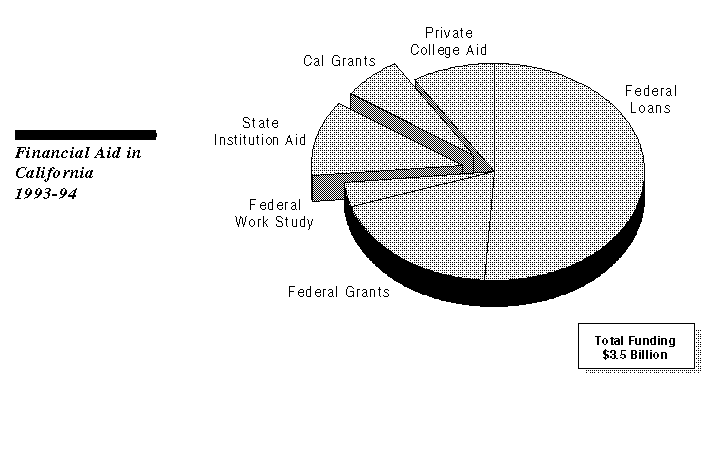
In 1994-95 total funding for California's three segments of higher education is $16.1 billion. This includes $4.5 billion from the General Fund and $1.4 billion from local property taxes.
University of California. General Fund spending at the UC grew at an average annual rate of 4.1 percent from 1988-89 to 1990-91. Since 1990-91, the fiscal constraints imposed by the state's recession resulted in an average annual reduction in General Fund spending of 3.8 percent (6.9 percent after adjusting for inflation).
Expenditures from the General Fund and student fee revenues (net of financial aid) grew at an average annual rate of 4.5 percent from 1988-89 to 1990-91. Since 1990-91, spending from these sources has decreased at an average annual rate of 0.8 percent (4 percent after adjusting for inflation).
California State University. General Fund spending at the CSU grew at an average annual rate of 5.4 percent from 1988-89 to 1990-91. Since 1990-91, the fiscal constraints imposed by the state's recession resulted in an average annual reduction in General Fund spending of 1.5 percent (4.8 percent after adjusting for inflation).
Expenditures from the General Fund and student fee revenues (net of financial aid) grew at an average annual rate of 5.8 percent from 1988-89 to 1990-91. Since 1990-91, spending from these sources has remained essentially flat in current dollars (and has decreased at an average annual rate of 3 percent after adjusting for inflation).
California Community Colleges. General Fund spending at the community colleges grew at an average annual rate of 10 percent from 1988-89 to 1990-91. Since 1990-91, the fiscal constraints imposed by the state's recession and a shift of funding from the General Fund to local property taxes resulted in an average annual reduction in General Fund spending of 11 percent (14 percent after adjusting for inflation).
Expenditures from the General Fund, local property taxes, loan funds, and student fee revenues (net of financial aid) grew at an average annual rate of 10 percent from 1988-89 to 1990-91. Since 1990-91, spending from these sources has increased by an average annual rate of 1 percent. (Spending has decreased at an average annual rate of 2.3 percent after adjusting for inflation.)
For the UC, the CSU, and the community colleges, the three major state-allocated funding sources are the General Fund, local property taxes, and student fees. From 1988-89 to 1994-95, total support from these funds increased from $6 billion to $7.1 billion.
During this time period, the General Fund share decreased from 81 percent to 63 percent. The share from local property taxes and student fees increased to 20 percent and 17 percent, respectively.
From 1990-91 through 1993-94, the UC and the CSU experienced significant declines in inflation-adjusted funding from the General Fund and net student fees. The UC also experienced a significant decrease in funding per full-time equivalent (FTE) student (12 percent). The CSU, however, experienced only a slight decrease in funding per FTE student. This is primarily because CSU experienced significant enrollment declines (11 percent). Enrollment declines were more modest at UC (2.3 percent).
The decline in funding (from the General Fund, local property taxes, net student fees, and loan funds) per FTE student at the community colleges was in the mid-range between the UC and the CSU--4.5 percent.
In 1990-91, California spent $350 per person from state and local revenues on higher education, which was $38 (12 percent) more than the national average. Of the ten largest states, only Michigan and North Carolina spent more.
It is not known how declines in the economy--both in California and nationally--have affected California's relative ranking since 1990-91.
In California's public institutions, average faculty salaries are highest at the UC and lowest at the community colleges. The UC's average faculty salaries are low relative to its eight comparison institutions nationwide. However, the CSU's average faculty salaries are high relative to its 20 comparison institutions. This is because the CSU has a greater concentration of faculty at the rank of full professor than its comparison institutions.
RESOURCES AND SPENDING
State and Local Support $5.9 Billion in 1994-95

General Fund Support of Higher Education Declining Since 1990-91
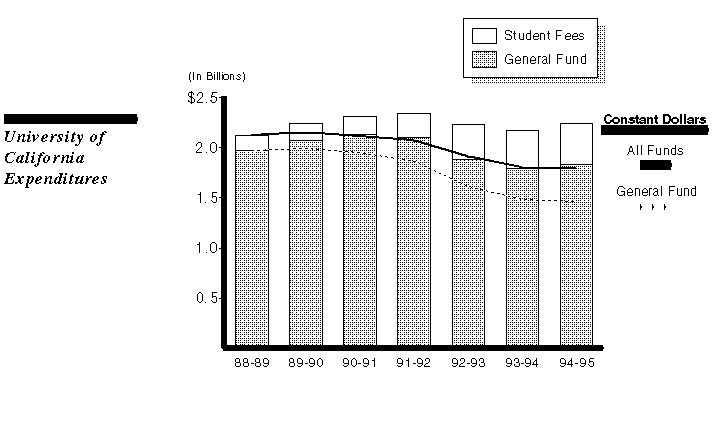
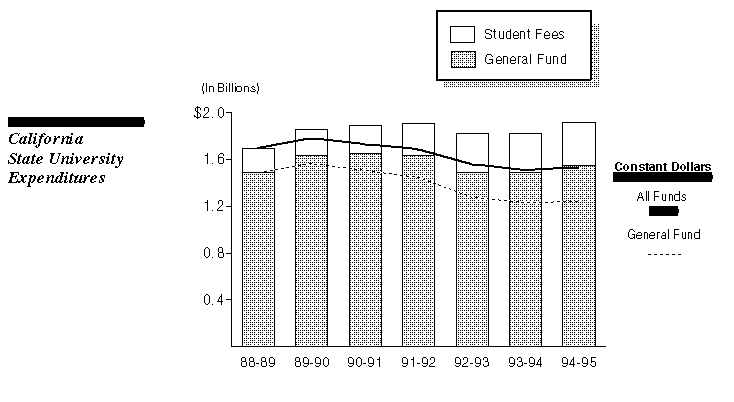
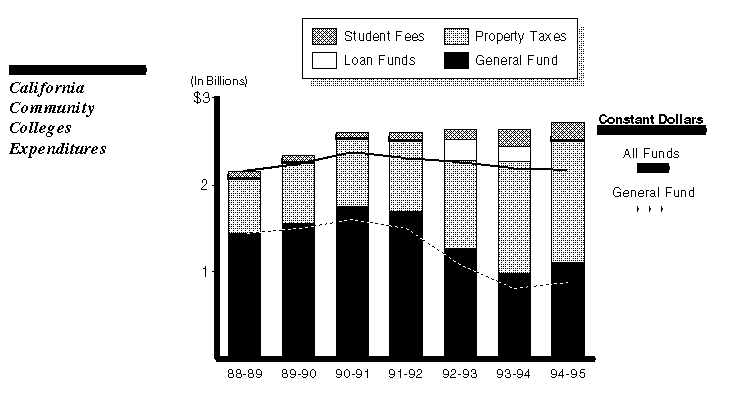
Student Fee and Property Tax Support Increasing
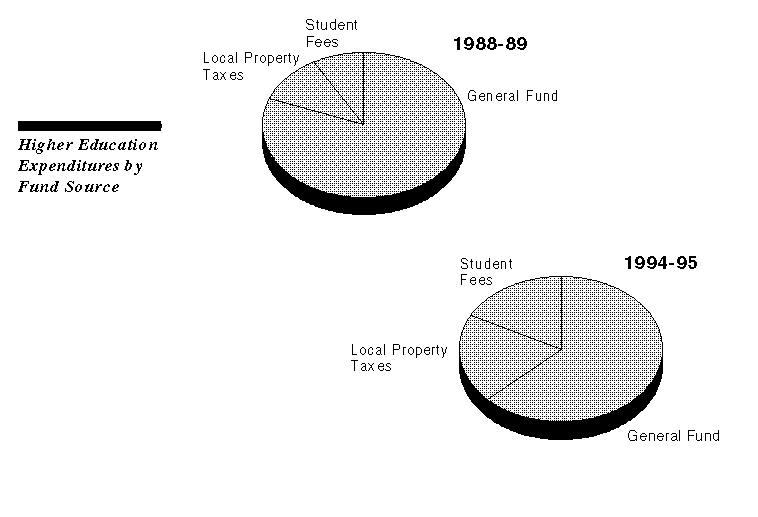
Funding Per Student Declining at the UC, Relatively Stable at the CSU
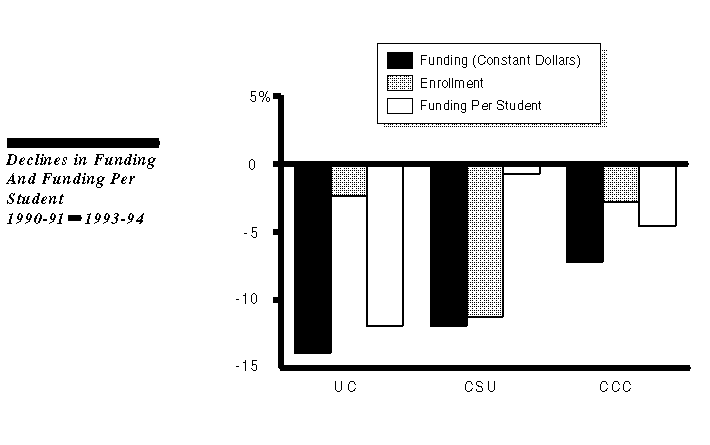
Per Capita Spending On Higher Education Higher Than National Average

Faculty Salaries Vary
